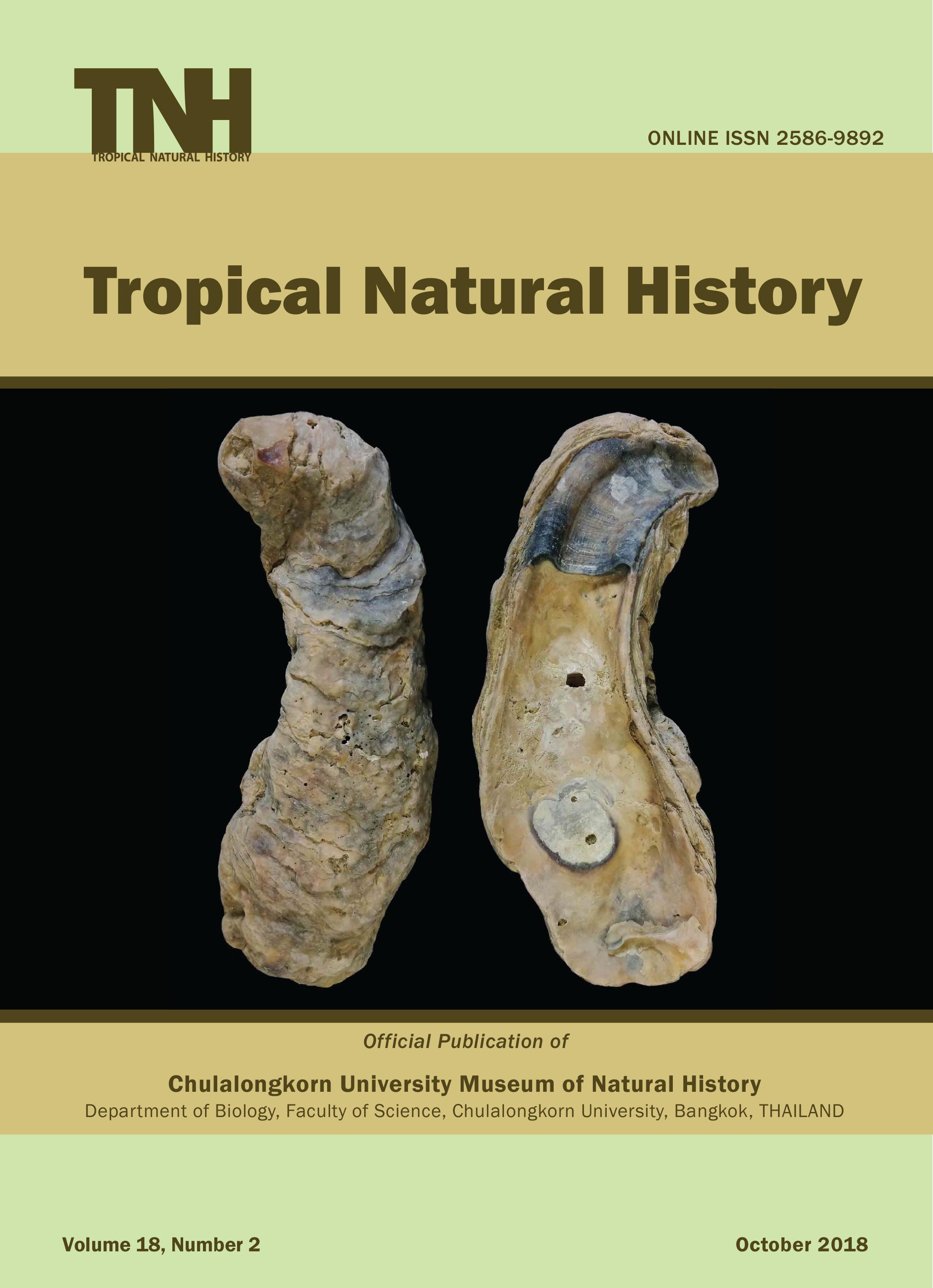Neotropical stingless bees Melipona quadrifasciata exploit the carcass of the giant toad Rhinella icterica in Southeast Brazil
DOI:
https://doi.org/10.58837/tnh.18.2.148184Keywords:
Neotropical stingless beesAbstract
Short Note
References
1. Roubik, D.W. 1989. Ecology and natural history of tropical bees. Cambridge University Press, Cambridge, x+514pp.
2. Cornaby, B.W. 1974. Carrion reduction by animals in contrasting tropical habitats. Biotropica 6: 51-63.
3. Crewe, R.M. 1985. Bees observed foraging on an impala carcass. Bee World 66: 8.
4. Baumgartner, D. and Roubik, D.W. 1989. Ecology of necrophilous and filth-gathering stingless bees (Apidae: Meliponinae) of Peru. J. Kans. Entomol. Soc. 62: 11-22.
5. Oliveira, M.L. and Morato, E.F. 2000. Stingless bees (Hymenoptera, Meliponini) feeding on stinkhorn spores (Fungi, Phallales): robbery or dispersal? Rev. bras. Zool. 17: 881-884.
6. Lorenzon, M.C.A and Matrangolo, C.A.R. 2005. Foraging on some nonfloral resources by stingless bees (Hymenoptera, Meliponini) in a Caatinga region. Braz. J. Biol. 65: 291-298.
7. Silveira, O.T., Esposito, M.C., Santos Jr., J.N. and Gemaque, F.E. 2005. Social wasps and bees captured in carrion traps in a rainforest in Brazil. Entomol. Sci. 8: 33-39.
8. Gomes, L., Gomes, G, Oliveira, H.G., Morlin Jr., J.J., Desuo, I.C., Queiroz, M.M.C.., Gianotti, E. and Von Zuben C.J. 2007. Occurrence of Hymenoptera on Sus scrofa carcasses during summer and winter seasons in southeastern Brazil. Rev. Bras. Entomol. 51: 394-396.
9. Toledo, R.C. and Jared, C. 1995. Cutaneous granular glands and amphibian venoms. Comp. Biochem. Physiol. 111A: 1-29.
10. Cabrera-Guzmán, E.C., Crossland, M.R., Pearson, D., Webb, J.K. and Shine, R. 2015. Predation on invasive cane toads (Rhinella marina) by native Australian rodents. J. Pest Sci. 88: 143-153.
11. Abernethy, E.F., Turner, K.S., Beasley, J.C., DeVault, T.L., Pitt, W.C. and Rhodes Jr., O.E. 2016. Carcasses of invasive species are predominantly utilized by invasive scavengers in an island ecosystem. Ecosphere 7: e01496.
12. Oliveira, I.S., Ribeiro, V.M., Pereira, E.R. and Vitule, J.R.S. 2016. Predation on native anurans by invasive vertebrates in the Atlantic Rain Forest, Brazil. Oecologia Australis 20: 70-74.
13. Rofela, C., Tsifoanya, M.T., Kwafo, R. and Tuadzra, E.K.A. 2017. Necrophagous insects succession on carrions’ of two tropical animals. Eur. J. Zool. Res. 5: 1-9.
14. Altmann, J. 1974. Observational study of behaviour: sampling methods. Behaviour 49: 227-267.
15. Batalha-Filho, H., Melo, G.A.R., Waldschmidt, A.M., Campos, L.A.O. and Fernandes-Salomão, T.M. 2009. Geographic distribution and spatial differentiation in the color pattern of abdominal stripes of the Neotropical stingless bee Melipona quadrifasciata (Hymenoptera: Apidae). Zoologia 26: 213-219.
16. Crossland, M., Brown, G. and Shine, R. 2011. The enduring toxicity of road-killed cane toads (Rhinella marina). Biol. Invasions 13: 2135-2145.
2. Cornaby, B.W. 1974. Carrion reduction by animals in contrasting tropical habitats. Biotropica 6: 51-63.
3. Crewe, R.M. 1985. Bees observed foraging on an impala carcass. Bee World 66: 8.
4. Baumgartner, D. and Roubik, D.W. 1989. Ecology of necrophilous and filth-gathering stingless bees (Apidae: Meliponinae) of Peru. J. Kans. Entomol. Soc. 62: 11-22.
5. Oliveira, M.L. and Morato, E.F. 2000. Stingless bees (Hymenoptera, Meliponini) feeding on stinkhorn spores (Fungi, Phallales): robbery or dispersal? Rev. bras. Zool. 17: 881-884.
6. Lorenzon, M.C.A and Matrangolo, C.A.R. 2005. Foraging on some nonfloral resources by stingless bees (Hymenoptera, Meliponini) in a Caatinga region. Braz. J. Biol. 65: 291-298.
7. Silveira, O.T., Esposito, M.C., Santos Jr., J.N. and Gemaque, F.E. 2005. Social wasps and bees captured in carrion traps in a rainforest in Brazil. Entomol. Sci. 8: 33-39.
8. Gomes, L., Gomes, G, Oliveira, H.G., Morlin Jr., J.J., Desuo, I.C., Queiroz, M.M.C.., Gianotti, E. and Von Zuben C.J. 2007. Occurrence of Hymenoptera on Sus scrofa carcasses during summer and winter seasons in southeastern Brazil. Rev. Bras. Entomol. 51: 394-396.
9. Toledo, R.C. and Jared, C. 1995. Cutaneous granular glands and amphibian venoms. Comp. Biochem. Physiol. 111A: 1-29.
10. Cabrera-Guzmán, E.C., Crossland, M.R., Pearson, D., Webb, J.K. and Shine, R. 2015. Predation on invasive cane toads (Rhinella marina) by native Australian rodents. J. Pest Sci. 88: 143-153.
11. Abernethy, E.F., Turner, K.S., Beasley, J.C., DeVault, T.L., Pitt, W.C. and Rhodes Jr., O.E. 2016. Carcasses of invasive species are predominantly utilized by invasive scavengers in an island ecosystem. Ecosphere 7: e01496.
12. Oliveira, I.S., Ribeiro, V.M., Pereira, E.R. and Vitule, J.R.S. 2016. Predation on native anurans by invasive vertebrates in the Atlantic Rain Forest, Brazil. Oecologia Australis 20: 70-74.
13. Rofela, C., Tsifoanya, M.T., Kwafo, R. and Tuadzra, E.K.A. 2017. Necrophagous insects succession on carrions’ of two tropical animals. Eur. J. Zool. Res. 5: 1-9.
14. Altmann, J. 1974. Observational study of behaviour: sampling methods. Behaviour 49: 227-267.
15. Batalha-Filho, H., Melo, G.A.R., Waldschmidt, A.M., Campos, L.A.O. and Fernandes-Salomão, T.M. 2009. Geographic distribution and spatial differentiation in the color pattern of abdominal stripes of the Neotropical stingless bee Melipona quadrifasciata (Hymenoptera: Apidae). Zoologia 26: 213-219.
16. Crossland, M., Brown, G. and Shine, R. 2011. The enduring toxicity of road-killed cane toads (Rhinella marina). Biol. Invasions 13: 2135-2145.
Downloads
Published
2018-09-29
How to Cite
[1]
SAZIMA, I. 2018. Neotropical stingless bees Melipona quadrifasciata exploit the carcass of the giant toad Rhinella icterica in Southeast Brazil. Tropical Natural History. 18, 2 (Sep. 2018), 146–149. DOI:https://doi.org/10.58837/tnh.18.2.148184.
Issue
Section
Short Notes
License
Chulalongkorn University. All rights reserved. No part of this publication may be reproduced, translated, stored in a retrieval system, or transmitted in any form or by any means, electronic, mechanical, photocopying, recording or otherwise, without prior written permission of the publisher












